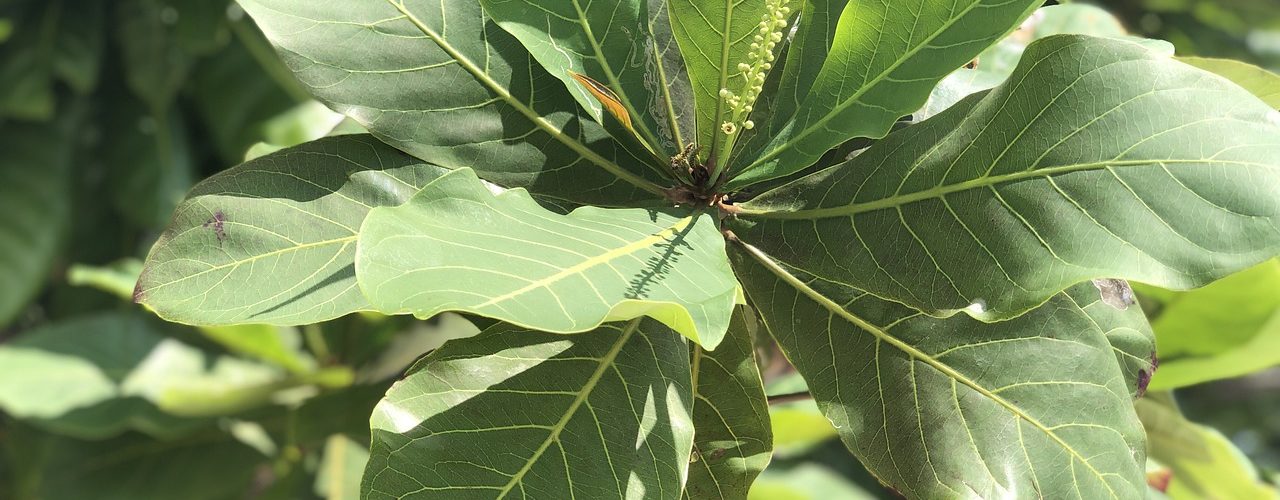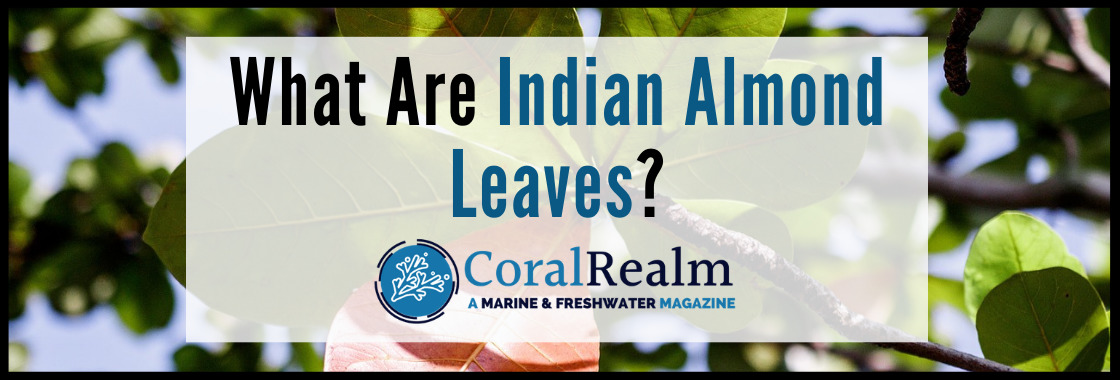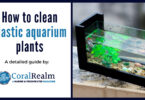Last Updated on December 8, 2021 by Matt
Indian almond leaves are the leaves of the Terminalia catappa tree. If you have been around the aquarium hobby a little while, or if you are a newbie who has done a bit of research, you have probably seen or heard of Indian almond leaves being used for various uses in the aquarium.
Uses of Indian almond leaves are many and varied in fish tanks, from medicinal properties to an extra food source for shrimp and fry, to helping with the breeding of some species.
In this article we will explain exactly what Indian almond leaves are, why you should consider using them in your tank setup, how to use them, and answer some frequently asked questions. Hopefully you will know all you need to at the end of the article!
IN THIS ARTICLE
What Are Indian Almond Leaves?
T. catappa is a large tropical tree which is found naturally in Asia, Africa, and Australia. It grows to 120 feet tall and produces a corky, light fruit which has an almond flavor, hence the common name of Indian Almond.
The branches of the tree are distinctly arranged in tiers, giving the tree a unique look. The leaves of the Indian almond tree are very large; 5.9–9.8 inches long and 3.9–5.5 inches broad. They are oval shaped, dark green in color, with a leathery texture. T. catappa is a deciduous tree species, which means that it sheds its leaves every fall. Before falling the leaves turn yellow or red. This coloration is caused by the presence of pigments such as zeaxanthin, which is also found in paprika and saffron and gives them their characteristic coloration.
Fallen leaves also contain a mixture of many different chemicals including tannins, flavonoids, saponines, and phytosterols. This richness of chemical compounds both the leaves and the bark of the Indian almond tree have seen use in many different indigenous and herbal medicines. The same chemical richness is why Indian almond leaves have such a cult following in the aquarium trade.
Why Use Indian Almond Leaves in your Tank?
Indian almond leaves have many different uses in aquariums, from helping control water quality to helping the breeding process. When you put the dried leaves into your aquarium, they will slowly break down and decompose. As they do the chemicals they contain are released into the water column.
In the following section we will run through some common uses of Indian almond leaves in fish tanks.
Controlling Water Quality
Indian almond leaves can be used to help control water quality. Not that these leaves should be used instead of a good aquarium filter, such as a HOB filter or canister filter, but they can help support them. As they break down in your tank they will release tannins and tannic acid.
Tannic acid will work to lower the pH of your aquarium. This can be extremely useful, especially if you have trouble with the pH creeping upwards or have had trouble with ammonia levels. Ammonia (NH3) is extremely toxic to fish, and causes ammonia poisoning even at very low concentrations. It is found in the tank in an equilibrium with non-toxic ammonium (NH4+); under pH 8 only trace amounts of ammonia are found, it will have been converted to ammonium.
Indian almond leaves are also said to lower the general hardness of the water. If you live in a hard water area this can be extremely useful indeed. They will also lower carbonate hardness. KH acts as an acidity buffer in an aquarium; as Indian almond leaves release tannic acid carbonates will be ‘used up’ to negate this.
Speeding the Healing Process
Indian almond leaves have been used for centuries as a natural medicine in all kinds of ailments, from liver diseases to dysentery and diarrhea. They contain many antioxidants and have antibacterial and antifungal properties, and are even touted to have cancer preventing agents as well. We have said that Indian almond leaves contain flavonoids, and these compounds have been linked with reduction in inflammation, amongst a number of other things. One flavonoid that is found in particular concentration in the Indian almond which has been linked with medical use is quercetin.
You can probably see why they have been used in such a wide range of diseases. They are often brewed into a tea for drinking. The same way that a person can drink tea from Terminalia catappa leaves and receive benefit, the aquarium can as well.
As the compounds found within the leaves are released, they are carried throughout the water column to surround and be ingested by the fish. Here the antibacterial and antifungal properties begin to show, helping fish to fight disease.
Bacterial diseases such as Columnaris Disease and Fin Rot can be prevented and treated with Indian Almond leaves, along with fungal diseases. This isn’t to say you shouldn’t also treat fish diseases with regular antibacterial and antifungal products, but Indian almond leaves could be a very good supplement. The inflammation reducing properties could be reason alone to use them.
Fish Breeding
If you are looking to breed fish which naturally prefer softer, more acidic water then using Indian almond leaves in the tank could be a very good idea. Many fish species need certain conditions met in order to breed, and need their natural environment mimicked as closely as possible.
Fish such as Betta fish, Khuli Loach, Discus, and Gouramis like the pearl gourami prefer acid pH ranges, and so will be much more likely to breed under these conditions.
These fish often prefer softer water as well. Which is just as well, as Indian almond leaves soften the water as well as lowering pH.
The leaves themselves can often provide a perfect place for fish to spawn as well. For example, Discus fish lay their eggs on leaf matter on the bottom of the tank, while Betta fish lay their eggs on floating leaves. Depending on what fish you are trying to breed you can either have the leaves floating or near the surface, or settled on the base of the tank.
Food Source for Fry and Shrimp
Fry and shrimp can be very picky when it comes to food. Most shrimp don’t care, but some are very finicky, especially baby and young shrimp.
As the leaves begin to decompose and release their chemical content into the water column, they also break down physically. This creates the perfect food source for fry, young fish, and young shrimp.
You will find fry swimming close to and nibbling on the leaves. Therefore you can be sure that they are getting the nutrition they need.
It isn’t only the leaves themselves that fry will be interested in. As the leaves break down infusoria will accumulate on the leaves to feed on the rotting material. Infusoria is a collective term meaning algae, protozoa, and small invertebrates. Fry and shrimp will find infusoria a very tasty treat!
Also having leaves at the bottom of the tank can create another close and closed environment where they can get away and hide from the larger adults, which often try to eat them!
Natural tank coloration and look
Indian almond leaves are well known for creating a more natural aquarium ecosystem, and a major reason for this is the coloration that they give the water. Asian blackwater habitats are a common home for many tropical freshwater fish, and Indian almond leaves are perfect for recreating this in the home aquarium.
The tannins released by the leaves essentially stain the water, creating an almost tea like tint. This can almost go against common sense; after all aquariums are meant to be perfectly crystal clear aren’t they?
Well, lots of freshwater fish are actually found in rivers, streams, and pools which have a substrate consisting of fallen leaves, branches, bark, and other decomposing matter. All this leeches tannins and other compounds into the water.
Therefore having Indian almond leaves in the tank can create a more natural feeling aquarium setup for your fish. Having your fish feel as natural and safe as possible helps to reduce their stress levels. Stressed fish are compromised and are by far more susceptible to diseases.
What Makes Indian Almond Leaves Ideal For Betta Fish?
Using indian almond leaves in Betta Fish care is a very common practice. So what makes these leaves perfect for using in Betta tanks?
Well, naturally Betta fish are found in slightly acidic, soft water which is quite heavily stained with tannins.
This is hopefully ringing a few bells! This is exactly what Indian almond leaves do in a fish tank. They make the water more acidic, softer, and also naturally stain the aquarium water through the released tannins.
All of this helps to make a Betta tank as close to the natural environment of Betta fish as possible. A natural tank means a comfortable and healthy, non-stressed fish. Including these leaves with Betta fish plants goes a long way to a more natural environment.
Betta fish are very susceptible to bacterial and fungal diseases. They are often kept in small tanks which can quickly get unhealthy. Bettas are very territorial and aggressive, and if kept in community tanks can get into scraps here and there. Any damage to scales and fins makes them more susceptible to disease.
As we have said previously, Indian almond leaves have antibacterial, antifungal, and anti-inflammatory properties. Having this in the tank gives Bettas a boost that they sometimes really need. Along with a betta filter indian almond leaves can really help their health.
Indian almond leaves can also play a vital role in breeding Betta fish. Not only do the leaves make the environment more natural for the fish, but Bettas build bubble nests on floating leaves. The leaves of the Indian almond float very easily, or can also be attached to the side of the aquarium with a fish clip. As such they are perfect for Betta fish to lay eggs on. Betta fish will often use the leaf as a Betta hammock to sleep on! Watching Betta fish sleeping can be fascinating.
As the eggs begin to hatch the leaves provide a perfect hideaway for baby Betta fry. The microscopic infusoria which thrive on the decaying leaves are a great source of food for them too.
How To Use Indian Almond Leaves
There are a number of ways in which Indian almond leaves can be used in the tank in order for you to see the beneficial properties.
As T. catappa leaves have an impact on water chemistry you should conduct regular water testing for pH, GH, and KH.
Indian almond leaf extract
Using a Terminalia catappa leaf extract will enable you to get the effect of Indian almond leaves in your aquarium without actually having the leaves themselves in your tank.
This can be very useful, as you have complete control over how much extract you put into your tank, and if you want less of an effect you can lower the dosage or stop altogether. If you have the leaves themselves in the tank it can be harder to remove.
There are some very high-quality Indian Almond Leaf extract products out there, such as the two below. Check with each product, but in general you should use 5ml per 2 gallons of water in a normal water change.
If you want to make your own extract, to keep costs down, simply follow the following guidelines. Take a leaf of Terminalia catappa, and rinse it and put it in a large heat proof jar. Boil some water, and pour two liters into the jar. Once the water has cooled down you should add some water conditioner into the jar as well.
Boiling the water kills bacteria, but the chlorine and heavy metals are still present. Once the leaf has broken down you can store the sealed jar in the fridge and use it for the next three months. You should use around 40 ml for every gallon of water in the tank.
Adding leaves straight into the tank
Putting Indian almond leaves directly into the tank is the easiest and simplest way of utilizing the leaves. They can be floated on the surface or sunk to the bottom to rest on the substrate.
In general you should use one Indian almond leaf for every 10 gallons of water in your tank. You should also rinse the leaves in treated tap water before putting them in the tank to remove dirt. If you use more than one leaf every 10 gallons then you can cause too much of an impact on the water, lowering the pH too much or darkening the water too much.
If your tank is smaller than 10 gallons you have split the leaf in half, or else you can soak it in water for a day or two, and leech out some of the tannins and other compounds before adding it to your tank. Remember to treat tap water with a water conditioner before soaking the leaf in it.
If you have Betta fish or other labyrinth fish floating the leaves on the surface is probably the better option; using a clip to keep them near the surface will ensure that they don’t sink. The leaves if left to float will naturally sink after a few days on the surface.
If you have young fish and shrimp then having them on the substrate is probably the better option. Here they will be able to explore and use the leaf fully. If the leaf keeps floating when you initially put it in the tank you can try weighing it down or half bury it in the substrate until it is waterlogged and stays at the bottom.
Take a look at what filtration system you are running in your tank. Chemical filtration media such as activated carbon will remove tannins from the water column, so if you want the natural darkened aquarium look, you will have to remove it.
Words of Caution
While using Indian almond leaves in a freshwater fish tank can be beneficial to all the fish, invertebrates, and yourself as well, you should always act with caution.
Using these leaves does change the water chemistry, so you want to do this as slowly as possible. Fish don’t act kindly to sudden quick changes in water chemistry. This can lead to fish becoming unwell. So always err on the side of caution; you can always add more, but if you’ve added too much, you are then trying to put out the fire!
Also make sure that the fish, invertebrates, and tank setup you have is appropriate for using Terminalia catappa leaves. The pH will be lowered, and the water will become softer.
If you have African Cichlids for example, which prefer alkaline harder water, Indian almond leaves are definitely not appropriate.
Catappa Leaves FAQs

Can You Use Too Many Indian Almond Leaves?
It is possible to overdose your tank with Indian almond leaves. That is why it is recommended to only use one leaf per 10 gallons of water.
If you use more leaves than this then you risk causing unwanted fluctuations in the water chemistry. Most likely if you are using almond leaves in your tank you want the pH or water hardness to be lowered. That is what the leaves will do, but you want this to be a slow process.
Fish are sensitive creatures, and quick rapid changes in pH, temperature, or anything really will cause them great stress.
That is why you should be testing your water regularly with a good aquarium test kit, such as API 5 in 1 strips which test for pH, general hardness, and carbonate hardness.
If you are testing wild swings in pH, then you should immediately conduct a large scale 50% water change and remove any leaves from the tank, and stop using extract if you are. Wait for the pH to cease fluctuating and you can start introducing a smaller amount of Indian almond leaves again.
Why Do Indian Almond Leaves Change The Water Color?
As we have mentioned in this article, Indian almond leaves contain tannins. Tannins are what dye or stain the water.
As the leaves decompose the compounds that they contain are released into the water column. As more tannin compounds are released, the more the water will become stained and darker as a result.
If you find that the water is becoming too dark, or you simply want to lighten the color, then there is something you can do. Activated carbon will remove tannins from the water column and so will clarify the water. Add activated carbon into the chemical filtration portion of your aquarium filter.
Are there alternatives to Indian almond leaves?
The special thing about Indian almond leaves is that they are multi-faceted. Not only do they reduce pH and water hardness, but they also have antibacterial, antifungal, and anti-inflammatory properties, whilst also introducing tannins to stain the water.
Not many, if any, products can offer such an array of benefits to an aquarium.
However there are some products out there that have similar effects.
Peat moss contains humic acid, tanning agents, and trace elements which act in a similar fashion to the compounds found in the Indian almond. Peat moss is also known as sphagnum moss, and the humic acid and tannins it contains work to lower the pH, water hardness, and slightly color the water. While technically you can buy the organic garden center peat moss, it is recommended to buy aquarium specific peat moss, as they will be guaranteed not to contain contaminants such as invertebrates, and will fit nicely into the chemical media compartment of your filtration system.
Natural driftwood, such as this natural malaysian driftwood also offer slightly similar properties to Terminalia catappa leaves. When placed in the tank not only does it look fantastic and offer protection for fish, it also slowly releases tannins into the water column. If you remember, tannins are what stain the water and create an Asian blackwater habitat look.
Alder cones also offer a great alternative to Indian almond leaves. They release tannins, have antifungal properties, and also work to reduce the pH of the water. Dwarf shrimp in particular love alder cones in fish tanks!
You can also use any fallen branches you find in your local area to similar effect. Remember that in the natural environment any branches, twigs, and leaves around will fall into water and provide these benefits. However be careful about introducing contaminants into your tank. Rinse, and soak branches well before putting them in a tank.
Conclusion
Hopefully this article on Indian almond leaves has been informative and useful.
Indian almond leaves are a great way of creating a more natural environment for your fish, and recreating an Asian blackwater habitat. In a more natural environment fish will be less stressed and more likely to breed.
If you have not got easy access to Indian almond leaves or can’t get hold of them for whatever reason, there are alternatives which offer similar effects, such as alder cones, peat moss, and driftwood.
Terminalia catappa leaves work to lower the pH, lower water hardness (both general and carbonate hardness), and stain the water through the release of tannins. The compounds the leaves contain also have antibacterial, antifungal, and anti-inflammatory properties, aiding in healing and helping to prevent disease.










